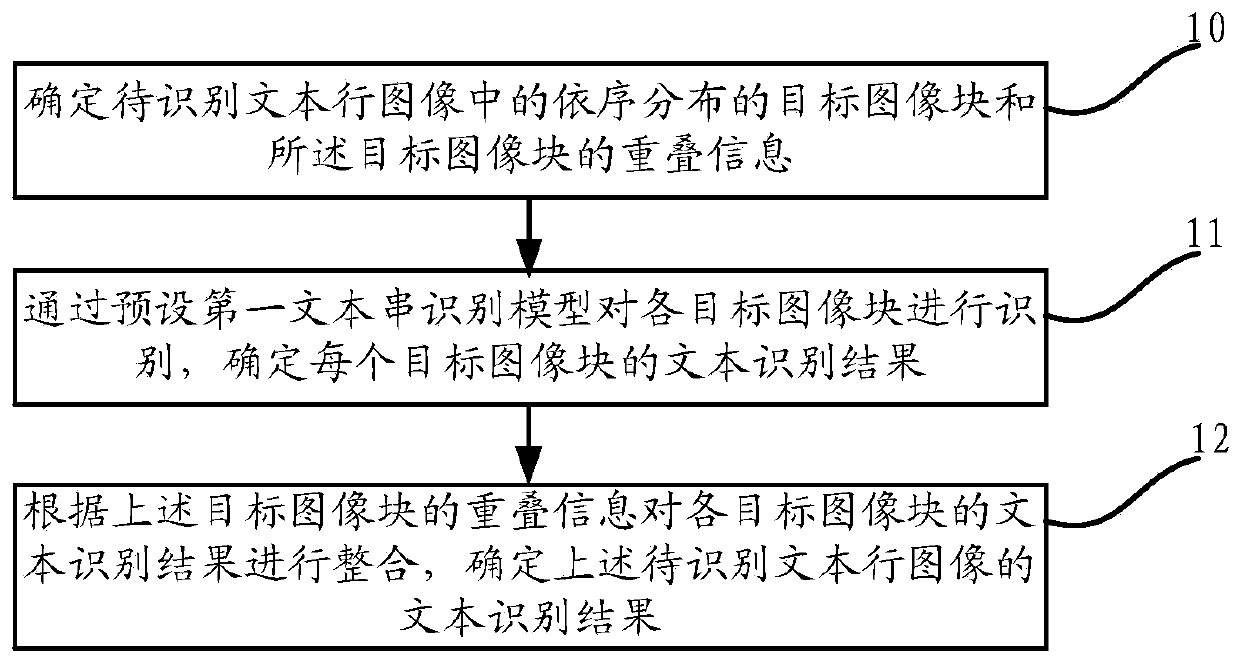Tibetan language recognition method and device and electronic device
A recognition method, text recognition technology, applied in the field of optical character recognition, can solve the problem of low accuracy of image recognition
- Summary
- Abstract
- Description
- Claims
- Application Information
AI Technical Summary
Problems solved by technology
Method used
Image
Examples
Embodiment 1
[0065] This embodiment provides a Tibetan recognition method, such as figure 1 As shown, the method includes: Step 10 to Step 12.
[0066] Step 10, determining overlapping information of target image blocks distributed sequentially in the text line image to be recognized and the target image blocks.
[0067] There are a large number of resources such as documents, ancient books, and scriptures recorded in Tibetan, and these Tibetan resources are generally preserved in the form of woodblocks. Due to the long age and the characteristics of the woodcut text itself, the Tibetan images of the woodcut boards obtained by taking photos or scanning have the following characteristics: poor image quality, blurred text, large noise interference, etc.; Glued characters; syllables and single vertical characters are relatively narrow, easy to glue with adjacent characters, because their width is smaller than other characters, it is difficult to recognize after glued. Therefore, if the Tibe...
Embodiment 2
[0111] This embodiment provides a Tibetan recognition method, such as Figure 4 As shown, the method includes: step 40 to step 46.
[0112] Step 40, determining the target image blocks distributed sequentially in the text line image to be recognized and the overlapping information of each target image block.
[0113] For a specific implementation manner of determining the sequentially distributed target image blocks in the text line image to be recognized and the overlapping information of each target image block, refer to Embodiment 1, and details will not be repeated in this embodiment.
[0114] Step 41: Recognize each of the above-mentioned target image blocks by using a preset first text string recognition model, and determine the text recognition results of each of the above-mentioned target image blocks.
[0115] For a specific implementation manner of identifying each of the above-mentioned target image blocks by presetting the first text string recognition model, and ...
Embodiment 3
[0151] Correspondingly, this application also discloses a Tibetan recognition device, such as Figure 6 As shown, the device includes:
[0152] The target image block information determination module 60 is used to determine the overlapping information of the target image blocks distributed in sequence in the text line image to be recognized and the target image blocks;
[0153] The target image block identification module 61 is used to identify each of the target image blocks by presetting the first text string recognition model, and determine the text recognition result of each of the target image blocks;
[0154] The recognition result integration module 62 is configured to integrate the text recognition results of each target image block according to the overlapping information of the target image block, and determine the text recognition result of the to-be-recognized text line image.
[0155] optional, such as Figure 7 As shown, the target image block information deter...
PUM
 Login to View More
Login to View More Abstract
Description
Claims
Application Information
 Login to View More
Login to View More - R&D
- Intellectual Property
- Life Sciences
- Materials
- Tech Scout
- Unparalleled Data Quality
- Higher Quality Content
- 60% Fewer Hallucinations
Browse by: Latest US Patents, China's latest patents, Technical Efficacy Thesaurus, Application Domain, Technology Topic, Popular Technical Reports.
© 2025 PatSnap. All rights reserved.Legal|Privacy policy|Modern Slavery Act Transparency Statement|Sitemap|About US| Contact US: help@patsnap.com



